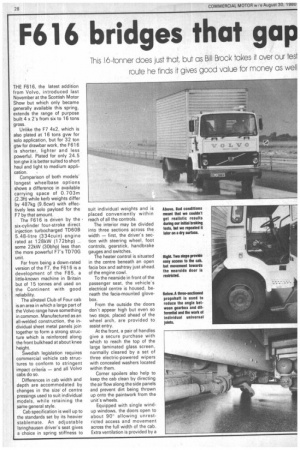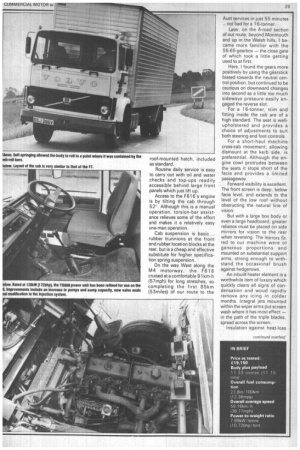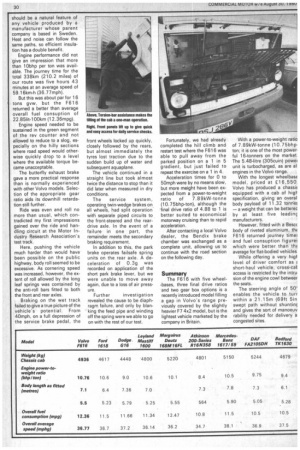F616 bridges that gap
Page 30

Page 31

Page 32

If you've noticed an error in this article please click here to report it so we can fix it.
THE F616, the latest addition from Volvo, introduced last November at the Scottish Motor Show but which only became generally available this spring, extends the range of purpose built 4 x 2's from six to 16 tons gross.
Unlike the F7 4x2, which is also plated at 16 tons gvw for solo application, but for 32 ton gtw for drawbar work, the F616 is shorter, lighter and less powerful. Plated for only 24.5 ton gtw it is better suited to short haul and light to medium application.
Comparison of both models' longest wheelbase options shows a difference in available carrying space of 0.703m (2.3ft) while kerb weights differ by 487kg (9.6cwt) with effectively less solo payload for the F7 by that amount.
The F616 is driven by the six-cylinder four-stroke direct injection turbocharged TD6OB 5.48-litre (334cuin) engine rated at 128kW (172bhp) some 22kW (30bhp) less than the more powerful F7's TD7OG unit.
Far from being a down-rated version of the F7, the F616 is a development of the F85, a little-known machine in Britain but of 15 tonnes and used on the Continent with good reliability.
The all-steel Club of Four cab is an area in which a large part of the Volvo range have something in common. Manufactured as an all-welded construction, the individual sheet metal panels join together to form a strong structure which is reinforced along the front bulkhead at about knee height.
Swedish legislation requires commercial vehicle cab structures to conform to stringent impact criteria — and all Volvo cabs do so.
Differences in cab width and depth are accommodated by changes in the size of centre pressings used to suit individual models, while retaining the same general style.
Cab specification is well up to the standards set by its heavier stablemate. An adjustable Isringhausen driver's seat gives a choice in spring stiffness to suit individual weights and is placed conveniently within reach of all the controls.
The interior may be divided into three sections across the width — first, the driver's section with steering wheel, foot controls, gearstick, handbrake gauges and switches.
The heater control is situated in the centre beneath an open facia box and ashtray just ahead of the engine cowl.
To the nearside in front of the passenger seat, the vehicle's electrical centre is housed, beneath the facia-mounted glovebox.
From the outside the doors don't appear high but even so two steps, placed ahead of the wheel arch, are provided to assist entry.
At the front, a pair of handles give a secure purchase with which to reach the top of the large laminated glass screen, normally cleared by a set of three electric-powered wipers with concealed washers located within them.
Corner spoilers also help to keep the cab clean by directing the air flow along the side panels and prevent dirt being thrown up onto the paintwork from the unit's wheels.
Equipped with single windup windows, the doors open to about 90 allowing unrestricted access and movement across the full width of the cab. Extra ventilation is provided by a roof-mounted hatch, included as standard.
Routine daily service is easy to carry out with oil and water checks and top-ups readily accessible behind large front panels which just lift up.
Access to the F616's engine is by tilting the cab through 52• . Although this is a manual operation, torsion-bar assistance relieves some of the effort and makes it a relatively easy one-man operation.
Cab suspension is basic rubber trunnions at the front and rubber location blocks at the rear, but is a cheap and effective substitute for higher specification spring suspension.
On the way West along the M4 motorway, the F616 cruised at a comfortable 91km-h (57mph) for long stretches, so completing the first 85km (53miles) of our route to the Aust services in just 55 minutes not bad for a 16-tonner.
Later, on the A-road section of our route, beyond Monmouth and up in the Welsh hills, I became more familiar with the S6-65 gearbox — the close gate of which took a little getting used to at first.
Here, I found the gears more positively by using the gearstick biased towards the neutral central position, but continued to be cautious on downward changes into second as a little too much sideways pressure easily engaged the reverse slot.
For a 16-tonner, trim and fitting inside the cab are of a high standard. The seat is wellupholstered and provides a choice of adjustments to suit both steering and foot controls.
For a short-haul machine cross-cab movement, allowing dismount at the kerb side, is preferential. Although the engine cowl protrudes between the seats it stops short of the facia and provides a limited passageway.
Forward visibility is excellent. The front screen is deep, below facia level, and extends to the level of the low roof without obstructing the natural line of vision.
But with a large box body or even a large headboard, greater reliance must be placed on side mirrors for vision to the rear when reversing. The mirrors fitted to our machine were ot generous proportions and mounted on substantial support arms, strong enough to withstand the occasional brush against hedgerows.
An inbuilt heater element is a worthwhile item of luxury which quickly clears all signs of condensation and woud rapidly remove any icing in colder months_ Integral jets mounted within the wiper arms put screen wash where it has most effect — in the path of the triple blades, spread across the screen.
Insulation against heat-loss should be a natural feature of any vehicle produced by a manufacturer whose parent company is based in Sweden. Heat and noise can follow the same paths, so efficient insulation has a double benefit.
Engine performance did not give an impression that more than 10bhp per ton was available. The journey time for the total 338km (210.2 miles) of our route was five hours 43 minutes at an average speed of 59.16km-h (36.77mph).
But this was about par for 16 tons gvw, but the F616 returned a better than average overall fuel consuption of 22.851it-100km (12.36mpg).
Engine speed needed to be sustained in the green segment of the rev counter and not allowed to reduce to a slog, especially on the hilly sections where road speed would otherwise quickly drop to a level where the available torque became unacceptable.
The butterfly exhaust brake gave a more practical response than is normally experienced with other Volvo models. Selection of the appropriate gear ratio aids its downhill retardation still further.
Ride was even and roll no more than usual, which contradicted my first impressions gained over the ride and handling circuit at the Motor Industry Research Association's test track, Here, pushing the vehicle much harder than would have been possible on the public highway, body roll seemed to be excessive. As cornering speed was increased, however, the extent of roll allowed by the long leaf springs was contained by the anti-roll bars fitted to both the front and rear axles.
Braking on the wet track failed to give a true picture of the vehicle's potential. From 40mph, on a full depression of the service brake pedal, the front wheels locked up quickly, closely followed by the rears, but almost immediately the tyres lost traction due to the sudden build up of water and subsequent aquaplane.
The vehicle continued in a straight line but took almost twice the distance to stop than it did later when measured in dry conditions.
The service system, operating twin-wedge brakes on all wheels, had split operation with separate piped circuits to the front-steered and the reardrive axle. In the event of a failure in one part, the remainder meets the secondary braking requirement.
In addition to this, the park brake operates failsafe spring units on the rear axle. A deceleration of 0.3g was recorded on application of the short park brake lever, but we were unable to move away again, due to a loss of air pressure.
Further investigation revealed the cause to be diaphragm failure, and only by blanking the feed pipe and winding off the spring were we able to go on with the rest of our test. Fortunately, we had already completed the hill climb and restart test where the F616 was able to pull away from the parked position on a 1 in 5 gradient, but just failed to repeat the exercise on a 1 in 4.
Acceleration times for 0 to 50mph were by no means slow, but more meight have been expected from a power-to-weight ratio of 7.89kW-tonne (10.75bhp-ton), although the final drive ratio of 4.88 to 1 is better suited to economical motorway cruising than to rapid acceleration.
After contacting a local Volvo dealer, the Bendix brake chamber was exchanged as a complete unit, allowing us to continue with the road section on the following day.
Summary
The F616 with five wheel • bases, three final drive ratios and two gear box options is a recently introduced model filling a gap in Volvo's range previously covered by the slightly heavier F7 4x2 model, but is the lightest vehicle marketed by the company in Britain. With a power-to-weight ratio of 7.89kW-tonne (10.75bhpton; it is one of the most powerful 16-tonners on the market. The 5.48-litre (305cuin) powei unit is turbocharged, as are al engines in the Volvo range.
With the longest wheelbasE model, priced at £16,550. Volvo has produced a chassis equipped with a cab of higf specification, giving an overal body payload of 11.32 tonne: a weight that can be betterec by at least five leadinc manufacturers.
However, fitted with a Bescc body of riveted aluminium, thE F616 returned journey time and fuel consuption figure! which were better than thE average for flat-bodied vehicles While offering a very higf level of driver comfort as short-haul vehicle, cross-cat access is restricted by the intru sion of the engine cowl betweer the seats.
The steering angle of 50' enables the vehicle to turr within a 21.15m (69ft 5in swept path without shuntinc and gives the sort of manoeuv rability needed for delivery a congested sites.




























































































